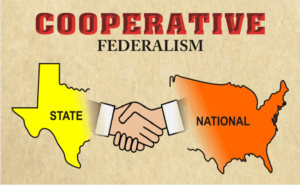Contents
COOPERATIVE FEDERALISM in USA
Cooperative Federalism
Cooperative federalism is a system of government in which power and responsibilities are shared between the central government and the state governments. In this model, both governments work collaboratively to solve shared problems and implement policies. The central government plays a major role in setting national goals, while state governments have the freedom to implement policies according to their particular needs. This model promotes government cooperation and mutual support to fostering unity and collective action and also gives flexibility to address various regional challenges while also taking care of national cohesion. Cooperative Federalism optimizes resources, minimizes duplication of efforts, and encourages innovation and experimentation at the state level. There are several prominent examples of cooperative federalism around the world, particularly the United States.
Cooperative federalism is also known as Marble-cake federalism which define the flexible relationship between the centre and the state and collaborative work on programs and issues.
Historical Background of Cooperative Federalism
- Cooperative federalism started from the time of the famous US President Thomas Jefferson, where the cooperation between the central government and the state governments started.
- In the 1800s, the federal government gave land to the states for things like colleges, former military benefits, and roads.
- Acts such as the Swamp Land Act and the Morrill Act gave federal property to the states for specific purposes.
- During President Franklin Roosevelt’s New Deal in the 1930s, cooperative federalism became important for helping to combat the Great Depression.
- It was during World War II, the Cold War, and President Lyndon B. Johnson’s Great Society programs, which dealt with poverty.
- In the 1960s and 1970s, cooperative federalism secured individual rights in areas such as housing, education, and the environment.
- After the 1970s, the federal government made it mandatory to enforce the policies and threatened to take away funds from those who did not follow the rules.
- Some experts think that the European Union is becoming more akin to cooperative federalism, where countries cooperate with each other to solve problems. Countries and unions in the European Union are solving social issues by cooperating with each other.
Fundamental Principle of Cooperative Federalism
The basic principles of cooperative federalism are:
- Shared Powers: In cooperative federalism there is a sharing of powers and responsibilities between the central government and the state governments. Both governments have their own jurisdictions and work jointly to solve problems.
- Interdependence: In cooperative federalism importance is given to the interdependence between the central and state governments. They are based on cooperation with each other to achieve common goals.
- Mutual Support: Cooperative federalism believes in mutual support so that the central government and the state governments work together to successfully implement policies and programs that are beneficial to the nation.
- Flexibility: Flexibility is the basic principle of cooperative federalism that allows states some flexibility to implement policies to address their unique needs and regional challenges.
- Nationwide Unity: The main aim of cooperative federalism is to maintain nationwide unity with recognizing and respecting interests of the individual states.
- Resource integration: Cooperative federalism often involves integration of resources, financial support and expertise, to meet shared challenges and enable efficient governance.
- 7. Inter-Government Cooperation: Positive communication and cooperation between the central government and the state government is important for successful governance in cooperative federalism.
- 8. Problem-solving approach: According to cooperative federalism, the primary importance should be the central government and the state government jointly solve the problems over all the individual interest or politics.
Working of Cooperative Federalism in US
The working of cooperative federalism in the United States involves the collaboration and shared responsibilities between the central government and state governments.
- Divison of Powers: The U.S. Constitution establishes a system of federalism, where certain powers are granted to the federal government, while others are reserved for the states. Cooperative federalism ensures that both levels of government work together to address complex issues.
- Grants-in-Aid: The central government provides financial assistance to state governments through grants-in-aid programs. These funds are allocated to states to support various policies, programs, and projects, fostering cooperation between the federal and state authorities.
- Federal Programs: Federal agencies design and implement programs that involve state participation. These programs often require states to follow federal guidelines, but they also allow flexibility in implementation to suit regional needs.
- Inter-state Compacts: States can enter into interstate compacts, which are agreements that allow them to address shared issues that cross state boundaries. These compacts facilitate cooperative actions among states to tackle regional challenges.
- Mandates and Regulations: While cooperative federalism emphasizes cooperation, the federal government may use mandates and regulations to ensure state compliance with specific policies or standards. However, in recent years, there has been a debate about the extent to which these mandates should be imposed.
- Intergovernmental Forums: Various intergovernmental forums and organizations, such as the National Governors Association (NGA) and the Council of State Governments (CSG), provide platforms for federal and state officials to interact, exchange ideas, and develop joint strategies.
- Disaster Management: During natural disasters and emergencies, cooperative federalism becomes particularly crucial. The Federal Emergency Management Agency (FEMA) and other federal agencies work alongside state governments to coordinate disaster response efforts.
- Social Programs: Social programs, such as Medicaid and Temporary Assistance for Needy Families (TANF), are jointly funded by the federal and state governments. States have some discretion in program design and administration, but they must adhere to federal guidelines.
- Education: The federal government supports education through programs like Title I funding for disadvantaged students. States play a key role in implementing education policies while complying with federal requirements.
- Environmental Regulation: Environmental protection is another area where cooperative federalism operates. Federal agencies, like the Environmental Protection Agency (EPA), set national standards, but states have the authority to implement and enforce regulations within their borders.
Challenges of Cooperative Federalism
There are also some challenges to cooperative federalism in US which sometimes put a question mark on the successful working of cooperative federalism US.
- Central and State Conflicts: Under Cooperative Federalism it is sometimes difficult to negotiate between the Central Government and the State Governments or implement the shared responsibilities in a coordinated manner. This conflict can manifest itself in various forms for some policy or program, which requires accurate timing and estimation of the relevant circumstances.
- Economic Issues: There can be various differences between the Central Government and the State Governments regarding the financial relationship or financial assistance. Disputes arise regarding the distribution of funds, financial discipline and cost sharing, which can affect the process of agreement and cooperation.
- Internal Political Agreement: Due to the conflict and isolation of various political parties in the state governments, it is sometimes difficult to follow the pro-cooperative federalism policies. Coordinating implementation of different policies at the level of government parties in different states can be a big challenge.
- 4. Culture and Local Identity: American culture strongly encourages autonomy and local identity, which can sometimes lead to antagonism to cooperative federalism. Local governments seek to protect their institutions and policies from the central government, which can lead to strains in the spirit of cooperation.
- Variability of the political landscape: The political landscape can change with every election, leading to changes in policy priorities and attitudes. In this matter of stability and moderation, co-operative federalism may be affected in getting the initiatives more skewed.
- Differences in policy priorities: Different states may have different policy priorities and priorities, which can make it challenging to reach agreement and consensus on certain topics.
- Bureaucratic Challenges: A centralized system with constituents can lead to bureaucratic hurdles, which can lead to delays and inability to coordinate action between the central government and the state governments.
- 8. Competing interests: With multiple stakeholders with different interests, it can be difficult to strike a balance between national and state-level goals.
- Unauthorized duties: Sometimes, the central government imposes unauthorized duties on states, which puts a strain on state resources and affects their ability to meet central requirements.
In spite of all the challenges, cooperative federalism in the United States fosters a collaborative approach to governance, where the central and state governments work together to address national and regional challenges, while also respecting the authority and diversity of individual states.
For More such Blogs:https://daytodayfacts.com/
For Details: https://en.wikipedia.org/wiki/Cooperative_federalism
